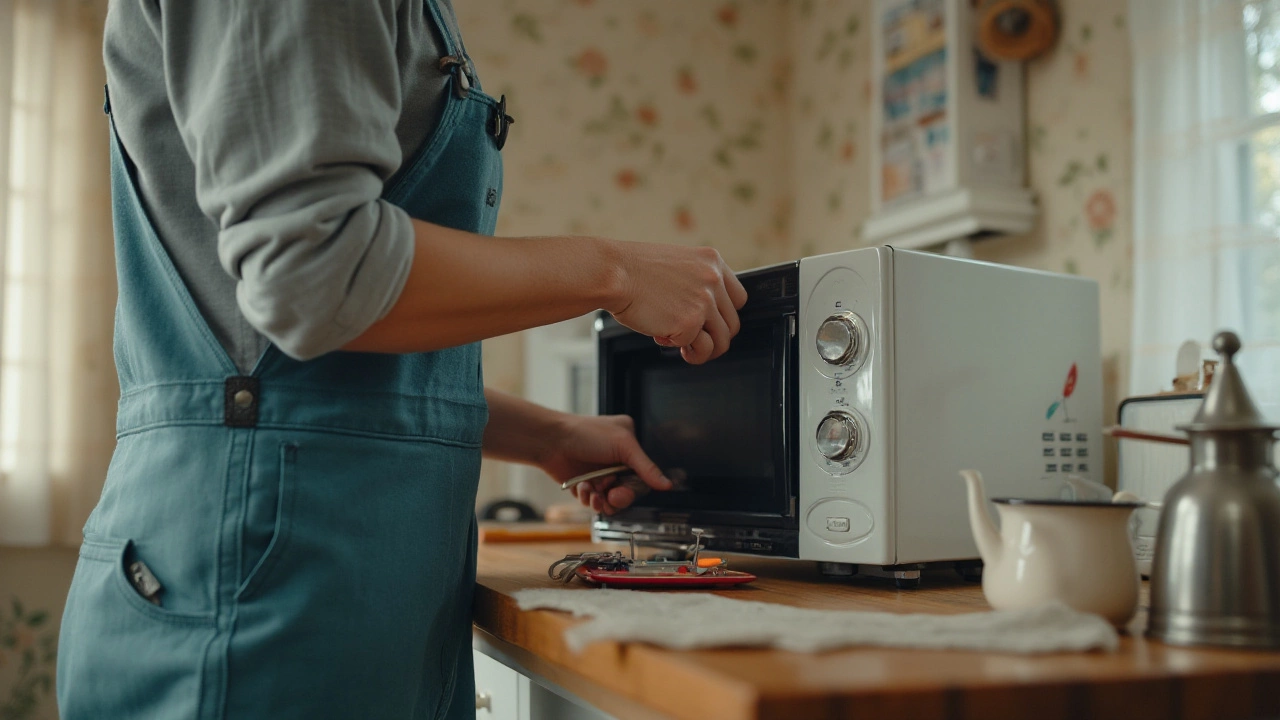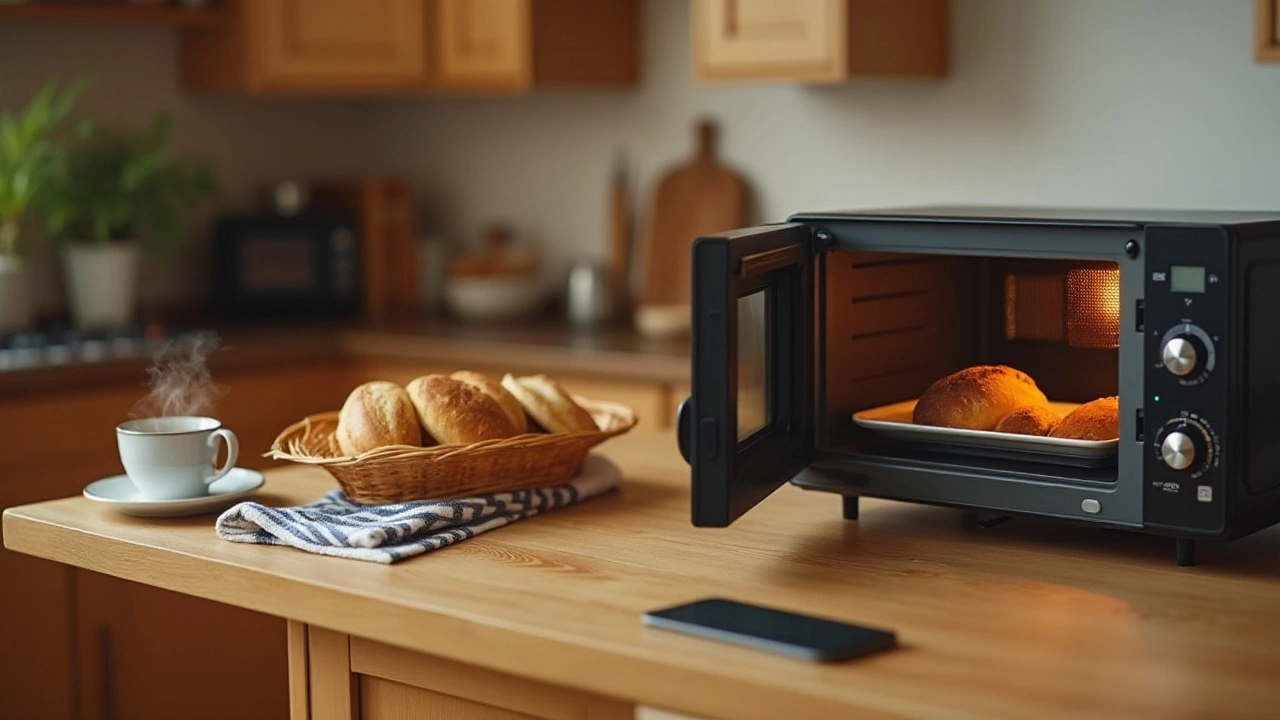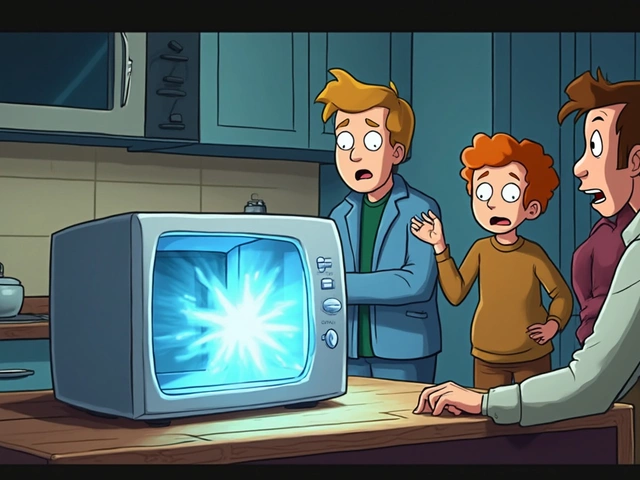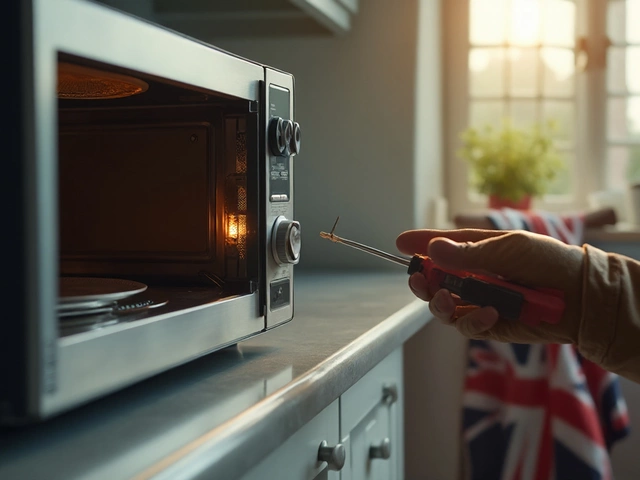Microwaves have become a staple in the kitchen for their speed and efficiency in warming meals. But like all appliances, they aren't immune to failure. Understanding what makes these trusty machines tick is the first step toward keeping them in top working condition. The most frequent hiccup that users encounter involves the microwave's door switch, a small yet crucial component.
Knowing how to diagnose and fix common microwave issues can save you time and possibly some cash. Whether it's a door that won't latch or a mysterious loss of power, we will delve into these problems and offer insights on how to address them. Let's explore how a combination of regular maintenance and timely troubleshooting can extend the life of your microwave.
- Understanding Microwave Mechanics
- Diagnosing Common Microwave Problems
- The Role of the Door Switch
- Identifying Electrical Issues
- Routine Maintenance Tips
- When to Call a Professional
Understanding Microwave Mechanics
Microwaves might seem like magical boxes that warm food with a quick push of a button, yet the science behind their operation is quite fascinating. At the heart of these devices lies a component called the magnetron, which is responsible for creating microwaves. These microwaves are a form of electromagnetic radiation, just like radio waves, though they cook our food by causing water molecules within it to vibrate, generating heat through friction. This process is why microwaves are incredibly efficient at reheating leftovers or making popcorn a cinch.
For the curious minds, the power output of an average household microwave sits around 700 to 1,200 watts. This range provides the right intensity to heat food quickly without causing unnecessary electricity consumption. The structure and features include a cavity, essentially the part we stack our food in, which is typically crafted from metal to prevent microwaves from escaping. Additionally, the turntable within the cavity ensures even cooking by allowing these waves to hit the food from different angles. Time magazine once noted how 'Microwave ovens have revolutionized meal prep across the globe, turning complex dinners into simple, quick-to-prepare affairs.'
Key Components and Their Interactions
Considering the parts individually, the control panel is your interface, allowing you to choose various settings that adjust the magnetron's power output. This flexibility is what makes a microwave adaptable to warming everything from a frozen burrito to a delicate cup of tea. The interior light helps monitor the cooking process, while safety measures like door switches prevent accidents by cutting the power if the door is open.
One might be interested to learn that the door itself is an intricate piece of mechanics. Featuring an interlocking mechanism, it's integrated with multiple switches to ensure the device only operates when securely closed. The control boards and transformers play their supportive roles by converting energy and managing the functions. When any of these parts flounder, or if the electricity supply isn't consistent, the entire system can come to a grinding halt, highlighting why understanding each element is crucial for appliance troubleshooting.
| Component | Function |
|---|---|
| Magnetron | Generates microwaves |
| Turntable | Ensures even cooking |
| Control Panel | Allows user settings |
| Door Switches | Secures microwave operation |
Diagnosing Common Microwave Problems
Let’s grab a cup of coffee and delve into the mysterious inner workings of your trusty microwave. You probably never think much about it, until it suddenly stops heating your leftover pizza or pops a fuse. Diagnosing microwave issues is as much about listening and observing as it is about technical know-how. When your microwave starts to act up, there are a few tell-tale signs that can point you towards the underlying problem. The most common microwave issues can often provide clues through strange noises, unexpected shutdowns, or unresponsive controls.
For instance, microwave buzzing sounds can indicate several complications; they might suggest a problem with the magnetron, which is the piece responsible for producing the micowaves used to heat your food. Arcing, or the sparking inside the microwave, can make loud popping sounds and might be due to a metallic object being on the plate or a simple buildup of food particles. Always ensure the interior is free of metal and kept spotlessly clean. A non-responsive control panel, on the other hand, often leads to the circuit board, and these can be pricey to repair.
"Regular inspection and cleaning can prevent most problems," says Emily Clarke, an appliance repair expert at Household Hub. "It's all about staying proactive and learning the sounds and quirks of your own appliance."
One of the most critical components to evaluate is the microwave's door switch. This tiny mechanism ensures the appliance only operates when its door is securely closed. If the microwave fails to start even after confirming the door is firmly shut, it's likely one of the door switches has worn out, preventing the circuit from completing. Fortunately, diagnosing a faulty door switch at home is relatively straightforward. You might also notice the microwave turning on but not heating, which could point to magnetron issues or blown thermal fuses.
When faced with electrical issues like short circuits, the prudent approach is often to leave the diagnosis and repair to a professional. Microwaves hold a deadly charge even after being turned off, so attempting a DIY fix without proper expertise can be dangerous. Always disconnect the power before attempting any repair. Understanding these early warning signs can help you pinpoint problems quickly and decide whether they are worth tackling yourself or best left to a technician. Whether it's adjusting a misaligned door or replacing a stubborn switch, addressing these issues promptly can extend the life of your microwave and save you the headache of unexpected breakdowns.

The Role of the Door Switch
The door switch in a microwave is akin to the unsung hero of the appliance world. This little component ensures that your microwave operates only when it's safe to do so. Once the door is closed, the switch locks everything in place, preventing the possibility of harmful microwave radiation leakage. When the door switch is faulty, your trusty appliance often refuses to start, leaving many baffled and stranded with cold meals. The door switch stands as the frontline defender, making it arguably the most important safety feature within your microwave.
Understanding how a door switch functions can demystify numerous microwave troubles. The door switch is typically a small plastic hinge or lever-activated button positioned in the main frame where the door closes. When you shut the microwave door, it triggers this switch, telling the appliance that all systems are, indeed, go. If this switch fails, however, the microwave won't start or may begin to emit warning sounds. According to an article by the Appliance Energy Efficiency in 2023, a malfunctioning door switch accounts for up to 20% of microwave issues worldwide, underpinning its crucial role in safe operations.
Given the prominence of the door switch in microwave repair conversations, many manufacturers ensure the incorporation of multiple switches for added security. Notably, most home enthusiasts can inspect the door switch themselves. Begin by unplugging the microwave and examining the integrity of the door latch. Listen for the click when you close it—a missing click often signals a problem with the switch.
Should you decide to replace the faulty switch, make sure to procure an exact match for your microwave model to avoid compatibility issues. This usually involves removing the microwave's case and carefully disengaging the faulty switch from its wiring harness. Remember, working with appliance components demands a measure of care and precision, and it's crucial to follow safety precautions. Just as you wouldn't wade into a pool without knowing how deep it is, don't dive into appliance repair without clear guidance.
If you find this repair daunting, reaching out to a professional is advisable. An experienced technician can make short work of most appliance troubleshooting instances, leaving you reassured right where it matters. While tackling simple repairs can be satisfying, knowing when to call in the cavalry ensures longevity and safety, both for the appliance and for peace of mind. Distrust of unknown solutions is healthy—it saves you from venturing into potentially risky DIY repairs based on unverified advice.
A seasoned technician once remarked in Consumer Reports, "No two microwave door switches are exactly alike; each plays a synchronized role in the orchestra of safe cooking." This highlights the intrinsic individuality of each component in contributing to overall appliance safety and performance. Appreciate and understand your microwave’s door switch, and you'll often be two steps ahead in maintaining your trusty kitchen companion.
Identifying Electrical Issues
When dealing with microwave repair, understanding the electrical aspects of these appliances is crucial, as many common faults stem from electrical issues. These problems can be as straightforward as a blown fuse or as complex as an intricate wiring fault. A key sign that your microwave might be suffering from electrical issues is if it simply refuses to start, or starts but won’t maintain power. To begin, the first step should always be to check the power source. Ensure the microwave is securely plugged into a working outlet, and consider testing the outlet with another device to verify its condition. A neglected tripped circuit breaker can often be the culprit in such scenarios, so checking your home's breaker panel to reset any bad circuits is also a prudent step.
The door switch, although often discussed, is electrically connected, and faults within can halt the microwave's functionality entirely. Malfunctioning door switches can prevent the appliance from receiving the necessary signal that it's safe to operate, effectively interrupting power flow. Fixing microwave door switch issues typically involves replacing the switch, a task that might require some technical knowledge and a steady hand.
"Many home appliance failures can be traced to simple electrical problems," notes Larry Weisman, an experienced appliance technician. "A large part of fixing these appliances is understanding how their electrical components integrate."
Another frequent issue with microwaves revolves around the internal fuse. These devices are equipped with one or more fuses that safeguard the internal circuits from power surges. If your appliance completely loses power, examining these fuses could provide answers. Using a multimeter to test fuse continuity can confirm if it needs replacement; however, dictate care and safety standards when working with electronics. Upon confirming a blown fuse, replace it with the exact same type to avoid additional electrical hazards. Another concern to be aware of is the voltage diode within your microwave, responsible for converting alternating current (AC) to direct current (DC). Should your microwave emit unusual noises or stop functioning mid-operation, the diode might be at fault. Replacing it can be complex and risky, often warranting a professional's touch if unfamiliar with electrical repairs.
Persistent issues with inconsistent power may also point to trouble within the microwave’s control board or its various connections. Control board repairs can be costly and often demand an understanding of the specific model. Regular cleaning and maintenance of your microwave can help prevent deposits of food particles or moisture from interfering with electrical contacts. Checking that the power supply cord is intact is another basic yet effective preventive measure. If there’s visible damage or wear, replacing the cord can negate potential hazards. Attempting to resolve complicated electrical dilemmas without sufficient expertise can be dangerous, so never hesitate to call in a professional when in doubt.

Routine Maintenance Tips
Keeping your microwave in prime condition isn't just about reacting to problems as they arise; it's also about maintaining it to prevent issues before they start. Although these appliances seem complex, a few simple maintenance routines can significantly extend their lifespan. First, make it a habit to clean both the interior and exterior regularly. After every use, wipe the inside with a damp cloth to prevent grease and food particles from building up. A clean microwave not only looks better but also functions more efficiently without stray crumbs impacting its performance.
For a deep clean, you can fill a microwave-safe bowl with water and add a few slices of lemon. Run the microwave on high for around five minutes, allowing the steam to loosen grime. Once complete, wipe down the surfaces. This not only cleans but freshens the interior. It's also crucial to avoid slamming the door; doing so is one of the quickest ways to damage the door switch, the component most often responsible for microwave failure. A gentle touch when closing can keep this part in working order for years.
Next, check the waveguide cover, a small mica shield on the interior wall, which ensures that the microwave’s rays are properly directed. If this part becomes discolored or burnt, it may need replacing. When using the microwave, ensure that the ventilation is unobstructed as this can cause overheating. Overheating can trigger the built-in thermal cut-out switch, disrupting your microwave use.
"Regularly inspecting the power cord can save you from unexpected surprises," advises Anne McGrath, a respected home appliance expert.
Another important aspect is to rotate the turntable manually every so often to keep its alignment in check. If it becomes misaligned, it can make the microwave operate inefficiently. Remember, just like all appliances, microwave repair costs can add up, so these small steps ensure you are able to prevent frequent and costly fixes. Finally, keep an eye on the lightbulb inside your microwave. Keeping it functioning well helps you keep track of dish progress.
These routine checks and cleanings form the foundation of a preventive maintenance routine. While they don't demand much time, the impact they have on the life and efficiency of your microwave is tangible. Many users are surprised by how long a bit of regular care can extend their appliance’s life, lessening the need for unexpected and perhaps costly repairs down the line. Stick to these tips, and your microwave will repay the favor by keeping your food warm and your kitchen running just a bit smoother.
When to Call a Professional
Owning a microwave means accepting that, at some point, minor issues may arise. While many problems can be handled with a bit of elbow grease and a set of screwdrivers, knowing when to step back and call a professional can save both your appliance and your peace of mind. Sometimes, you must recognize the limits of do-it-yourself repairs; after all, microwaves are complex appliances with potentially hazardous components.
One red flag is the persistent failure of critical parts such as the magnetron. This component is essentially the microwave's heart, responsible for generating the energy that heats your food. It can operate under high voltage, which poses a serious risk if tinkered with incorrectly. If you find your microwave runs but doesn't heat food properly, it might be magnetron trouble, and that's when a skilled technician should take over. Attempting to replace a magnetron without the proper training could lead to further damage or personal harm.
Another telltale sign for professional assistance is any kind of electrical burning smell. This odor suggests that something inside the microwave is overheating or failing, potentially leading to more severe internal damage or even fire hazards. A technician with knowledge of microwave repair will have the tools and savvy to pinpoint and resolve such issues safely. According to the National Fire Protection Association, appliances account for a significant portion of house fires, emphasizing the importance of addressing suspicious smells immediately.
If your microwave displays notoriously cryptic error codes or experiences issues beyond simple troubleshooting, like complete loss of power with no breaker issue, it might indicate an underlying electrical fault. Many modern microwaves come with digital interfaces that can complicate straightforward repairs. Professionals have access to diagnostic tools that can interpret these codes accurately and efficiently repair the issue. Trying to fix an electrical problem without proper insight can be both frustrating and risky.
"A well-trained technician not only fixes what's broken but also checks the overall health of your appliance," notes appliance repair expert Mike Stevens, underscoring the value of professional services.
Besides operational failures, consider aesthetic or structural damages like persistent rust inside the cavity or a shattered turntable. These issues not only affect the microwave's functionality but also its safety and reliability. A professional will know how to tackle these problems without creating additional complications, ensuring the appliance continues to operate safely. Structural integrity is crucial, especially in an appliance that uses electromagnetic waves. Fixing microwave issues like these demands more than a handyman's skills; it requires experience and specialized knowledge that a trained technician can provide.
If you're ever in doubt, consulting a professional isn't a defeat—it's a step toward preserving the longevity and efficiency of your kitchen companion. Prioritizing safety over cost will ensure your microwave continues to work seamlessly and safely, offering the convenience you've come to rely on.




